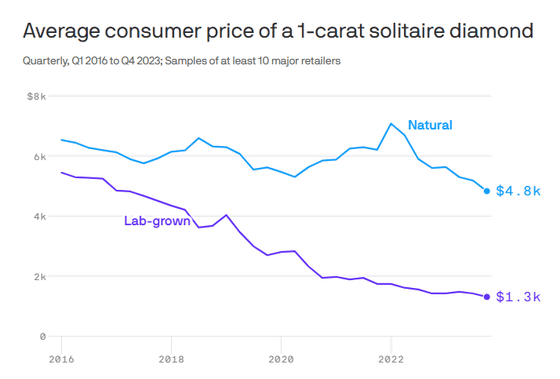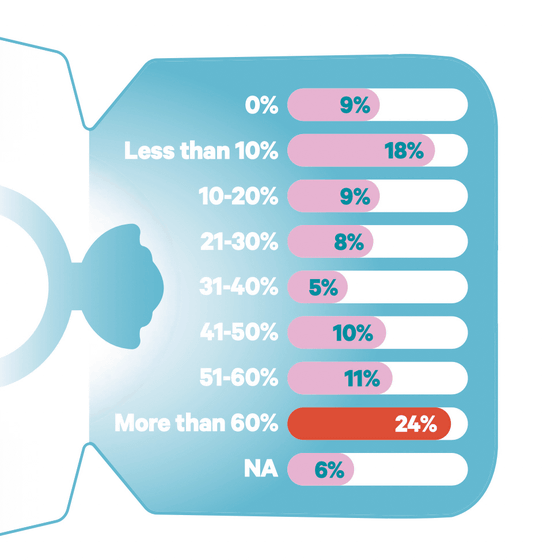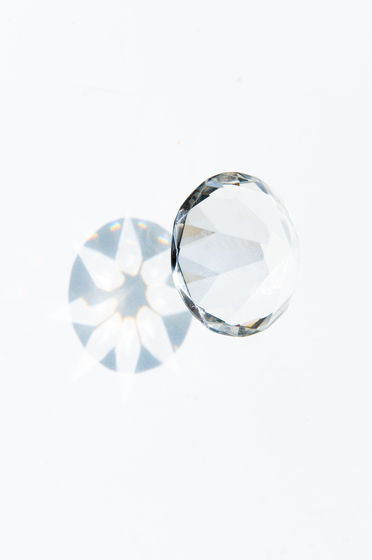“Lab-grown diamonds”, artificial products with the same ingredients as natural diamonds, have a large presence in the diamond market

'
The Big Survey 2023: Lab-Grown Diamonds
https://instoremag.com/the-big-survey-2023-lab-grown-diamonds/

Lab-grown diamonds drive cost of all diamonds down
https://www.axios.com/2023/12/24/diamonds-lab-grown-natural-price-cartier-dousset
According to the Gemological Institute of America (GIA), lab-grown diamonds have the same chemical and physical properties as natural diamonds. In 2018, the Federal Trade Commission (FTC) certified that 'lab-grown diamonds are diamonds,' and in 2019, GIA stopped using the word 'synthetic' for lab-grown diamonds.
According to industry analyst Paul Zimnisky, record demand for natural diamonds in 2021 and a lack of supply have led to a rise in the price of natural diamonds in 2022. As a result, demand for lab-grown diamonds, which can be purchased cheaper than natural diamonds, has increased significantly. The line graph below shows the trends in the average price per carat of natural diamonds and lab-grown diamonds, showing that lab-grown diamonds (purple line) are cheaper than natural diamonds (light blue line). Masu.

According to the latest survey of American independent jewelers conducted by

The answers to the question, 'What is the average gross profit margin for the lab-grown diamonds you sell?' vary considerably, with the lowest being '10%' and the highest being '250%.' The average gross profit margin was 75.6%. However, the most common answer is '50%', with 4 out of 10 jewelers responding '50%'. According to data from Tenoris, a consulting firm founded by industry analyst Edaan Golan, the average gross profit margin for natural diamond rings for independent jewelers in the United States in 2022 was 48.6%. You can see that lab-grown diamonds have a higher gross profit margin than that of diamonds.
The image below summarizes the answers to the question, 'What percentage of the engagement rings you sell use lab-grown diamonds?' The most common answer is 'more than 60%' (24%).

On the other hand, when asked, ``Are lab-grown diamonds eligible for trade-in?'' only 8% answered ``Yes, they are eligible for trade-in just like natural diamonds.'' However, 11% of jewelers said they would trade in lab-grown diamonds at a lower price than natural diamonds, while only 19% of jewelers said they accept trade-ins for lab-grown diamonds in the same way as natural diamonds. was. On the other hand, 50% of respondents answered, 'No, but we do trade in natural diamonds,' and 17% said, 'No, we do not trade in diamonds, whether synthetic or natural.' %', and 14% had no response.
When asked, 'How many lab-grown diamonds do you sell each month compared to natural diamonds?', 13% answered '0' and 13% answered 'less than one-tenth'. ``24%'' answered ``about 1/10,'' ``11%'' answered ``about 1/5,'' ``11%'' answered ``about 1/4,'' and ``about 1/4.'' ``6%'' answered ``About a third'', ``9%'' answered ``About one-third'', ``9%'' answered ``It's about the same (as natural diamonds),'' and ``Lab-grown diamonds are more expensive than natural diamonds.'' 17% said they sell a lot of products.
When asked, 'Have there been any reactions from customers since the price of lab-grown diamonds fell?', 6% answered 'yes', 13% answered 'sometimes', and 13% answered 'sometimes'. 81% answered 'no'.

At the time of writing, there were not many jewelers who responded that they had received a response from customers due to the drop in the price of lab-grown diamonds. INSTORE speculates that the reason why so many customers are not yet outraged by the drop in lab-grown diamond prices is because lab-grown diamonds are still a relatively new product.
One jeweler who responded to INSTORE's survey said, ``While we haven't seen much of a reaction to the drop in lab-grown diamond prices yet, there is a strong possibility that lab-grown diamonds will become more expensive within the next five years, when first marriages will start to break up.'' I predict that there will be a lot of dissatisfaction from customers (dissatisfaction such as the fact that the price is clearly lower than when they purchased it).''
Some jewelers always tell buyers of lab-grown diamonds that ``prices are falling and there's no telling when they'll hit rock bottom,'' and ``a diamond ring is a financial guarantee for the future.'' 'It's not an investment, it's an investment in love,' some people say emphatically to their customers. Another jeweler said, ``Some buyers are dissatisfied with the drop in value, even though we were informed at the time of purchase that the value of lab-grown diamonds could decline.''
Regarding lab-grown diamonds, some jewelers say, ``In order to be transparent with our customers, we communicate that ``due to power consumption and lack of regulation, lab-grown diamonds are less ethical than natural diamonds.'' We also clearly communicate that lab-grown diamonds are likely to have no intrinsic value: ``If you buy a computer on a 24-month loan, by the time you pay off the loan, the computer will be worthless.'' We explain that the price of lab-grown diamonds may also be decreasing, just as the price of lab-grown diamonds is likely to be lower than the cost of purchase. 'I believe in helping people make the best decisions possible,' one person said.

Jean Doucet, the great-great-grandson of Louis-François Cartier, the founder of French luxury jewelry brand Cartier , is one of those in the industry who is paying close attention to the potential of lab-grown diamonds. ``The diamond industry is facing an existential crisis,'' he said, ``the diamond industry is facing an existential crisis,'' he says, ``the diamond industry is undergoing an existential crisis.'' 'The introduction of lab-grown diamonds has breathed new life into the diamond industry.'
According to the overseas media Axios, more and more millennial women are looking for lab-grown diamonds when purchasing engagement rings, and a large part of the reason is that they are cheaper to purchase than natural diamonds. Mr. Zimnisky pointed out that there is.
Related Posts:
in Note, Posted by logu_ii







